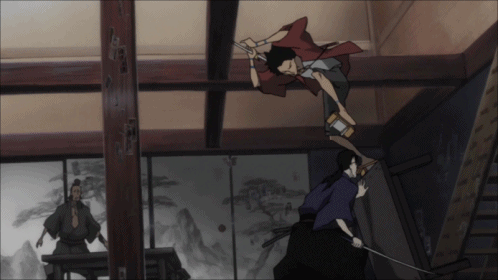
Samurai Champloo
Due to swords being so common in fantasy, many people think they’re very easy to use in battle. At least in a fictional sense. Swing, stab, parry, stab, slash, stabbity stab, and the cycle continues. You can be very simplistic with your sword fights in those aren’t one of the highlights of the story. If you want to put more meat on the action bones then you’ll have to consider more aspects of swordplay.
- Most moves in a swordfight are designed to create an opening. Unless the opponent is severely outmatched or unaware of the danger, a full on slash or stab will probably get blocked. This means you need to consider feints (fake attacks), parrying (blocking), and various other moves that are designed to disrupt an opponent’s defense. The actual strikes where blood is drawn will be fewer, especially any that cause major damage.
- Injuries that don’t kill will force a swordsman to adjust. They can’t keep moving at their original speed if they have wounds. The pain slows them down immediately and, if things progress, the blood loss causes weakness. This is why you have to remember injuries and dole them out sparingly unless you have a reason why the characters can keep going at top speed while wounded. Location is important here too because the sword arm being slashed will have a greater impact than the non-sword arm.
- The style of fighting must match the physical skills of the combatant. It’s not a one style fits all. A fast character will be better suited to use quick strikes and dodging instead of heavy blows and parrying. They would be building up speed and trying to throw their opponent off-balance. In contrast, strong characters will try to overpower with strong blows and minimal footwork. They’d be more likely to act as a wall and not try to out maneuver an enemy.
- Swords need maintenance just like any other piece of gear. If you have a character who doesn’t take care of their blades then you have to consider that they will break in a battle. Those nicks and scratches make for a subpar blade as well as any spots where it could be too dull to cut skin. All you need to fix this is a few scenes where the swordsman is talking while sharpening or mending their weapons. Can even it do it once and people will assume it’s always being done.
- Speaking of footwork, you don’t have to make it flashy. There doesn’t need to be flips and spins, which would normally get you stabbed at the point where you aren’t looking at your opponent. These are fun since it’s a fantasy setting, but we go back to the moves having to fit the character. For example, Luke Callindor is a dual-wielding swordsman who uses speed and agility to create openings. Him flipping around makes sense as well as him getting hit a lot. Delvin Cunningham is a traditional sword and shield warrior, so he’s not going to be in the air every often. It’s more parrying and countering with him, which is why he gets hit less than Luke.
- It’s not always the pointy end going into the other man. Sometimes it’s the sharp part going through the other man. Slashing is a thing, especially against someone with thin or no armor. Even against an armored opponent, a slash has force and can knock that person to the side enough to create an opening. So, a slash isn’t always done when there’s a clear shot.
- It really isn’t that easy to chop a head off. In fact, it requires the opponent to be unable to strike back. Think of swinging a baseball bat, but you’re aiming at something higher and meatier than a baseball. You have to get through bone too and it’s usually not from the back like an executioner with an axe. You’re typically come from the side or the front with no gravity to help either. So, this is a move that should be unleashed carefully . . . or not because it is flashy.





The description of beheading causes me to double think that move. This is a super tutorial for anyone writing a sword battle or scene.
LikeLike
Thanks. Glad you enjoyed it.
LikeLiked by 1 person
The information you give here–and the knowledge behind it–is excellent. This is exactly why I didn’t mention swords. And this is exactly why the creators of Avatar sought the expertise of the martial arts master who guided them in the development of the various styles of martial arts they used for their characters’ fighting styles. What also helped was the fact that one of them studied under this master and had the benefit of that training to help enhance realismn. You have that benefit because of your training. I don’t have that at all.
LikeLike
Thanks. Fiction does allow for flexibility and exaggeration. Just has to be some limits or just go totally over the top. Fencing isn’t the same as story and historical swordsmanship too. It’s in a straight line with solid rules. There’s no dodging to the side or shots to the throat. So, that only gave me a general foundation that I had to work off of.
LikeLiked by 1 person
Yes, the historicity aspect and the knowledge of terrain and force of thrust are things I simply don’t know how to even begin to research. I’m reminded of a behind the scenes documentary for Peter Jackson’s LoTR adaptations. Christopher Lee talked to the director about the authentic noises a person would make after being stabbed (having been in combat; he knew about these things). I appreciate that depth of knowledge.
LikeLike
That’s a fairly nuanced example though. Most audience members wouldn’t know the difference. With sword fighting, watching videos of re-enactments and movies can help. It gives you a good idea on how one uses the weapon. Accuracy won’t be 100%, but it’s good for readers who don’t know at better.
LikeLiked by 1 person
“It really isn’t that easy to chop a head off.” Something that usually doesn’t get mentioned about those executions: it often took more than one chop to take the victim’s head off. And that’s with a heavy ax wielded by a strong man who’s probably done this more than a few times. Decapitating someone with a sword? Highly unlikely, unless there’s something extraordinary — magical blade, superhumanly strong wielder, etc. — about the situation. And forget taking off an arm, cutting someone in half, or that sort of thing.
LikeLike
I always thought those axes were made to work with gravity for extra power. Still figured it took at least two whacks. Only way I can really see a one shot is a freshly sharpened blade that strikes exactly where there’s a space between bones with gravity on its side and the target in the perfect position.
LikeLiked by 1 person
Take a look at a drawing/photo of a human spine sometime. There’s no gap running clear between vertebrae, because those bones interlock; there is no space for a sword blade to just slide through without striking bone, even with “the target in the perfect position.”
LikeLike
So, I looked it up. There is a small chance that you can behead someone with a sword in one shot. Depends on sword and wielder’s skill, but this is for execution. As far as the spine, there are small spaces that appear and disappear. A sword edge could feasibly get in there of keen enough and have less bone to push through. This again is highly unlikely and depends on the target not putting up a fight.
LikeLike
Apparently, Anne Boleyn was executed by a single sword strike beheading. This was an event planned by her husband for ideal circumstances though.
LikeLike
Love this post. I want to write one that includes knife fighting and I’ve mapped out the idea of being hit – in the armor- with a sword. It would still hurt like hell. In my case it isn’t steel armor. You have to give a lot of credit to slashing value, too. I think those samurai did plenty of beheading, but slashing was part of it due to the shape of the weapon. Also, bone isn’t that hard to chop through. I’ve cut up enough beef to understand that one, and our bones are much smaller. Even cutting up a deer, the neck is the easy part with a cleaver. It never comes free with one stroke because the meat keeps it together. However, with a slashing kind of sword, I can see it finishing the job quite well. When I start the story with the knives, I intend to make them kind of brutal.
LikeLiked by 1 person
Swords tend to be either slashing or stabbing. I think it’s curved blades primarily slash and straight blades stab. They can do both, but they’re better at one motion than the other. Interesting about the bone thing. I’m guessing it’s harder on a moving target though. Aren’t the bones at the neck thinner than legs and arms? I’ve never had to do it, so I’m now rather curious.
Brutal knives? Sounds cool. Specific knife styles?
LikeLiked by 1 person
I think the humerus is tougher than the spine. When you get into the lower arm, the bones are pretty tiny. I’m thinking Arkansas toothpick style knives.
LikeLike
I always forgot what kind of knife that is. I imagine a machete or something.
LikeLiked by 1 person
Like a big dagger. Almost a predecessor to the Bowie. I’ll have to explain that in the tale or even add it to the cover somehow.
LikeLike
Finally got a chance to look it up. Says it’s similar to the Bowie Knife. That one always confused me. I know it’s named for Jim Bowie, who used it. Yet, I keep thinking it’s connected to David Bowie.
LikeLiked by 1 person
Ha ha!
LikeLike
Great post, Charles. And the type of sword has an effect, too. A two handed sword will be used very differently from something like a Roman gladius.
LikeLike
Thanks. Excellent point that I think a lot of authors forget. Though, I’ll admit that I’ve consciously ignored physics for ‘cool factor’ a few times. It’s a tough decision to make when one writes action adventure.
LikeLike
The fantasy I am working on is one where there are firearms and I have been playing with the idea of swords against firearms and then against magic as well. I feel like there can be some fun combinations here. Live the posts!
LikeLike
Glad you enjoyed the posts. That could be some fun combos. I’ve seen a few video games that have those three. Personally, I always wondered how possible guns would be if hurling fireballs and lightning were possible.
LikeLiked by 2 people
I plan to play with those ideas exactly. Good times. Brandon Sanderson plays with some of these ideas in the second trilogy of the Mistborn books, but his magic system is so bizarre that it works really well with it. Hahaha.
LikeLiked by 1 person
I have a series I want to do much further down the road with a group who uses Wild West-type pistols. My world is very high magic, which is why it’s hard to rationalize having that tech evolve naturally. I want to see how they fit on a small level too. That and I don’t really like writing gunfights as much as swordfights.
LikeLiked by 2 people
I can understand that. I’m trying to “write what I know” so to speak and guns are familiar to me. 😄
LikeLiked by 2 people
Got it. I’m the same with swords.
LikeLiked by 1 person
This was a delightful read and a great reminder in general. I’ll have to keep it in mind with the book I’m editing at the moment. I was aware of a few points you brought up but it’s always great to keep them at the forefront, especially when you don’t have a lot of magic or enhancements to really make unlikely things possible in your world. haha Might have to follow up with coldhandboyak too if he wrote the article about knives. In regard to the last point, I understand the head being particularly challenging to lop off in one swing and have heard as much. Does the same apply to limbs, barring the thigh with its massive humerus. >.> I wonder as it’s something that is also often seen wherein a character loses a hand in battle. I get it when it’s stationary and that’s the point, but in the heat of battle, I hadn’t really thought about the plausibility so much. Hmm.
LikeLiked by 1 person
Not sure about limbs. Guess it depends on the weapon and location. Shoulders and hips seem too thick for one slice, but elbows and knees may be possible. Wrists and ankles aren’t as thick, so I could see losing the extremities as a common event. Might be easier with an axe though.
LikeLiked by 2 people
Fair points. I could also see the sword having a similar effect as effectively chopping off a limb though if it was only partially severed. Depending on the technology in the world, there likely might not be any way to reattach the mangled limb. Hmm. Don’t mind me. Just gruesomely thinking out loud at this point. >.> Not without reason though. I might well be implementing such a thing in a story / book in the future. Time will tell!
LikeLiked by 1 person
Think all fiction authors who have sword fights consider limb reattachment at some point.
LikeLiked by 2 people
Fantastic list! I knew some of this, but not the more strategic aspects. Reminds me of Musashi’s The Book of Five Rings.
Thank you for sharing this!
LikeLiked by 1 person
Glad you enjoyed it. I remember a friend going on about the Five Rings. Been so long that I forgot everything.
LikeLiked by 1 person
It’s worth the time, if you get a chance. He focuses a lot on how to win duels and the mindset one needs to have. Great book. 🙂
LikeLiked by 1 person
Thanks. I’ll talk to my friend about it. Think he still has a copy somewhere.
LikeLiked by 1 person